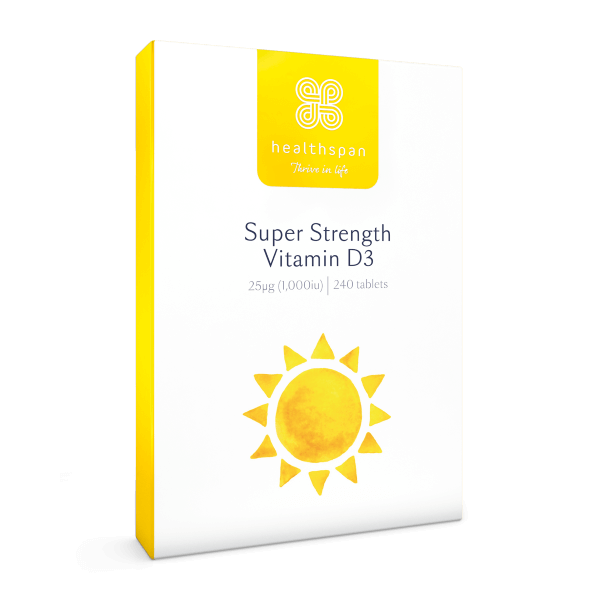There are many health benefits associated with sufficient vitamin D levels. Here's how to make sure you're getting enough.
You might know vitamin D as a nutrient solely responsible for efficient calcium absorption and therefore skeletal health, but this super vitamin helps to maintain a healthy immune system, may help to control blood sugar1 levels and could have an impact on your mood, too.
But how can we ensure we get enough vitamin D each day? And is it possible to reach the recommended intake through diet? This article is here to help.

Read this guide to why vitamin D is important, and how to make sure you're getting enough.
Read more
How much vitamin D do we need daily?
The optimal level of vitamin D for one person is much higher than once thought. When vitamin D was all about calcium absorption, the recommended intake was just 5mcg per day. Now the National Institute for Health and Care Excellence (NICE) recommends that all adults in the UK take a daily supplement containing 400IU (10mcg) of vitamin D from October to March.
Research now suggests that many people need higher amounts to maintain good vitamin D status – especially in later life.2 Many experts are calling for everyone to supplement at a higher level all year round. The majority of adults need between 25mcg (1,000IU) to 50mcg (2,000IU) of vitamin D per day for optimum health, especially if they're already deficient or have a higher risk of deficiency.3
One thing we do know is Brits – on average – are lacking in vitamin D. National Diet and Nutrition Survey (NDNS) results show that 17% of adults have low levels of vitamin D all year round.
Unfortunately, the absorption of vitamin D varies significantly per person based on factors such as skin colour and body weight. For example, those with dark skin absorb less vitamin D from the sun, and those who have a larger fat percentage tend to have a higher risk of vitamin D deficiency, due to absorbing nutrient supplements less effectively.4
Using sunscreen with a high SPF also reduces vitamin D production in the skin by screening out UV rays.
Can we get enough vitamin D from sunlight?
During autumn and winter in the UK, your skin cannot produce enough vitamin D through reacting to sunlight, as the sunshine between October and March is simply not strong enough. One rule of thumb is that if your shadow is longer than you are tall, you won't be producing enough vitamin D.
Even during the summer months, the amount of vitamin D we make from the sunshine on our bare skin is highly variable. Some of the factors that affect how much vitamin D we make in our skin include:
- The time of day
- Our latitude
- How dark our skin is – the darker our skin, the less vitamin D we make
- The use of sun cream – sunscreen blocks our natural production of vitamin D
- How much of our body is exposed to the sun
- How old we are
- Our body size and whether we are overweight
- Even altitude, air pollution, and how overcast it is can affect how we make vitamin D from sunshine
What's more, many of us simply don't get enough sun exposure. We spend too much time indoors, or we cover up with sunscreen (something we must do to protect our skin) when we're outside, which inhibits vitamin D synthesis.

Super Strength Vitamin D3
For healthy bones, teeth, muscles and immunity
- 25mcg vitamin D per tablet
- Helps keep bones, teeth and muscles healthy, and supports immunity
- Multiple health benefits from €0.06 a day
Can we get what we need from our diet?
Sadly, there are few reliable dietary sources of vitamin D. This is especially the case for vegetarians and vegans, as vitamin D is split into two different types: vitamin D2 and vitamin D3. The latter (vitamin D3) comes from animals and is twice as effective at raising vitamin D levels in the body compared to its plant-based vitamin D2 counterpart.5
Many vegan milks, cereals, and juices are fortified with vitamin D2, which is less easily absorbed by the body. Most products contain very low amounts of the nutrient, too – typically 0.75mcg (30IU) per 100ml.
Which foods contain vitamin D3?
The food group highest in vitamin D3 is oily fish, which includes salmon, sardines, and mackerel. A small fillet of salmon (about 80g) provides around 10mcg (400IU) of vitamin D3, although factors such as the species of salmon, whether it's wild or farmed and the season during which the fish was caught may affect this estimate.
Sardines and mackerel are also good sources of vitamin D3, with 80g of mackerel providing roughly 10mcg (400IU) of vitamin D, and a small tin of sardines (120g) roughly 6mcg (240IU).6
Although oily fish is a good source of vitamin D3, most of us are unlikely to eat it every day. Additionally, the most you're likely to get from one portion is 10mcg (400IU), and perhaps less. Given that the average Brit needs at least 25mcg (1000IU) of vitamin D per day, you'd have to eat several fillets of wild salmon, or five whole tins of sardines, each day to reach this target.
Another good source of vitamin D3 is beef liver, with 80g providing up to 1mcg (40IU). Although this allows you to top up your intake, it would be unrealistic and unhealthy to eat the equivalent of 25mcg. Likewise with egg yolks, which provide about 1mcg (40IU) per egg. If you wanted to achieve a daily intake of 25mcg from eggs alone, you'd need to eat a whopping 25 eggs every day.6
It's easy to see why diet provides such a low proportion of our daily vitamin D requirements. There simply aren't enough vitamin D-rich foods that can feasibly be incorporated into our meals. Diet should always come first, so although it cannot provide enough vitamin D to stop deficiency and support optimal levels, it's important not to discount food sources of vitamin D as an important top-up. Every little helps, after all.
So, what's the solution?
The reality is that vitamin D supplementation is the most effective and least invasive solution to maintaining healthy levels of vitamin D. Taking just one vitamin D supplement daily, all year round, helps to ensure that you're getting enough every single day. No need for unfeasible diets or continuous sun exposure.
This doesn't mean that we should discount the sunshine or our diet as helpful ways to keep our vitamin D levels topped up. Rather, we should be looking to use supplements alongside the right food and sensible sun exposure to ensure we're not deficient in what's proven to be an absolutely essential nutrient.






